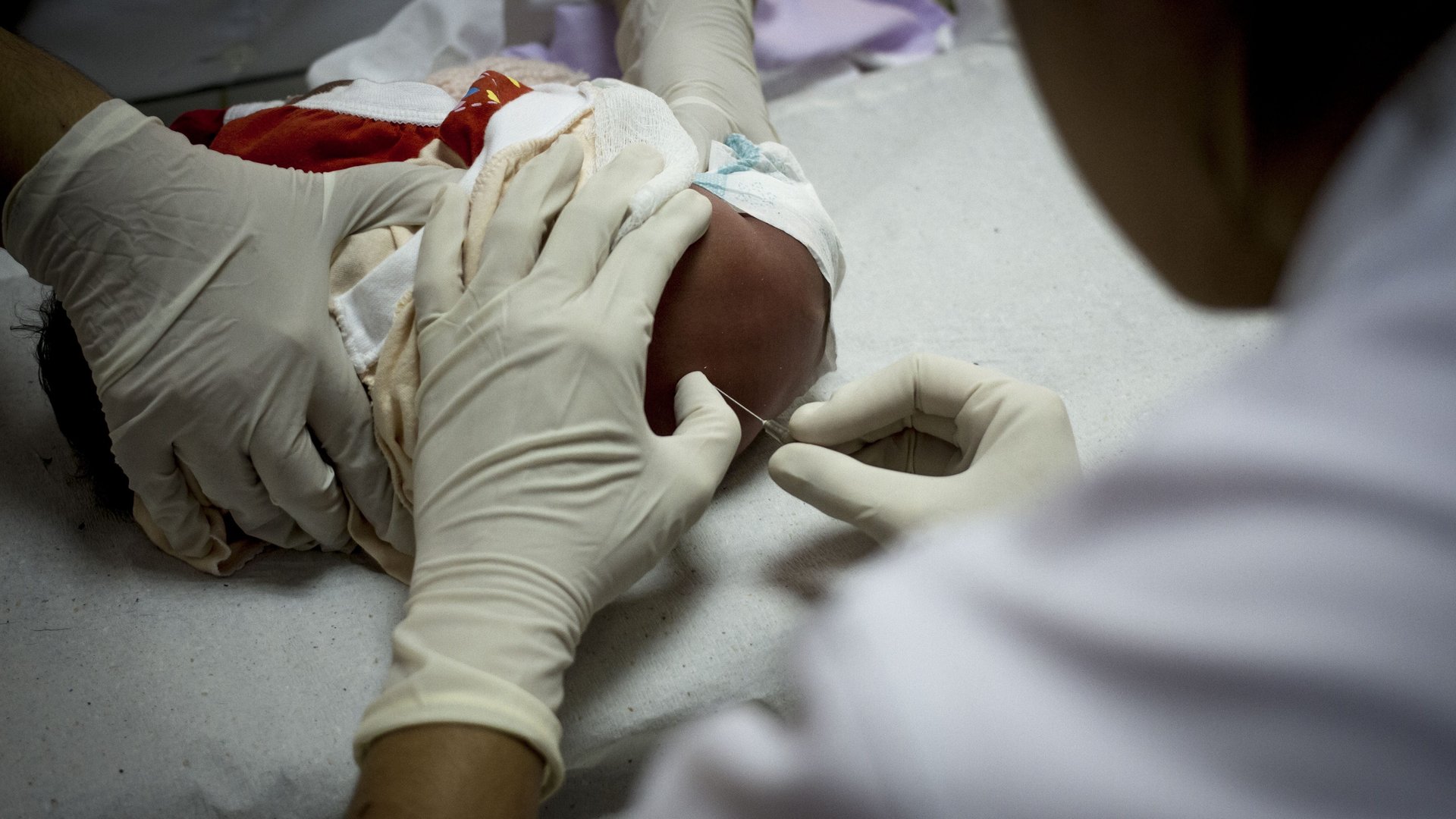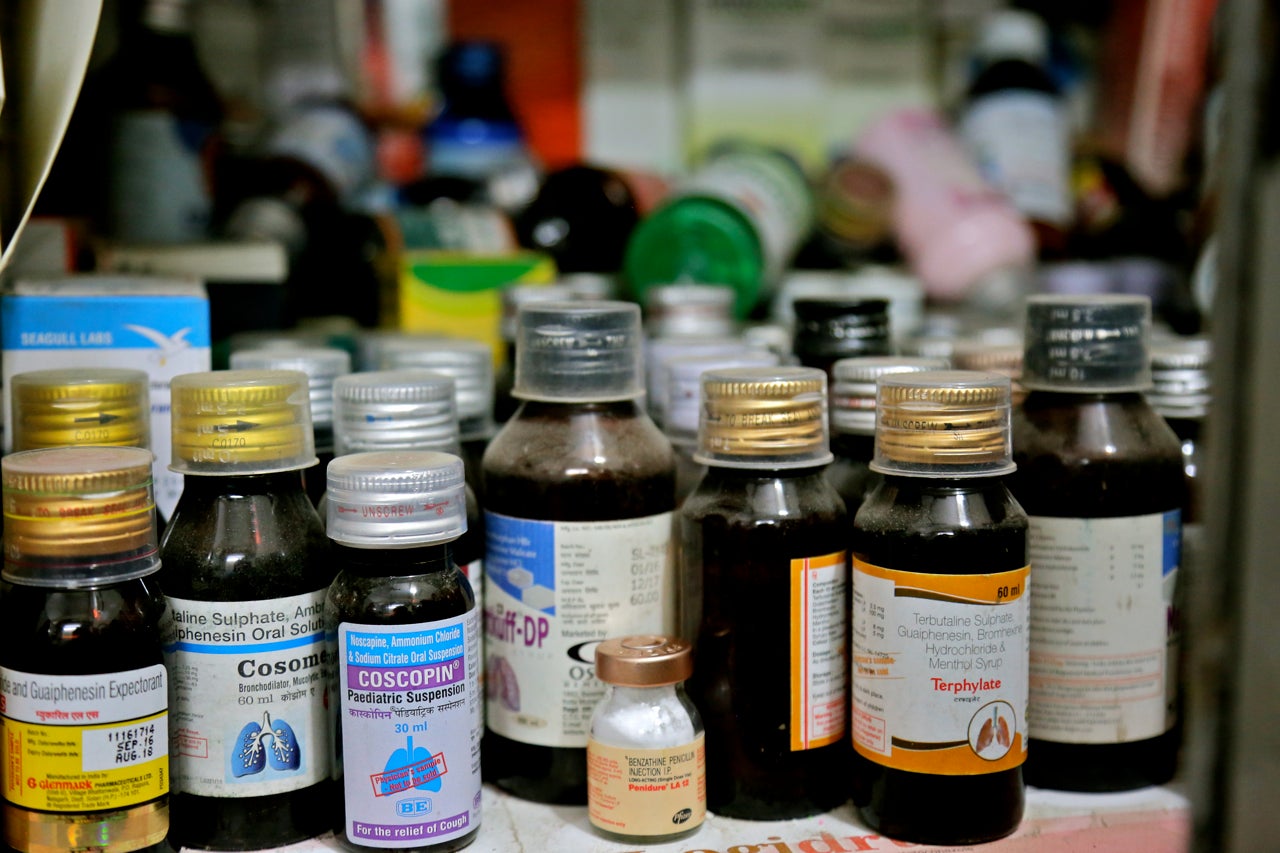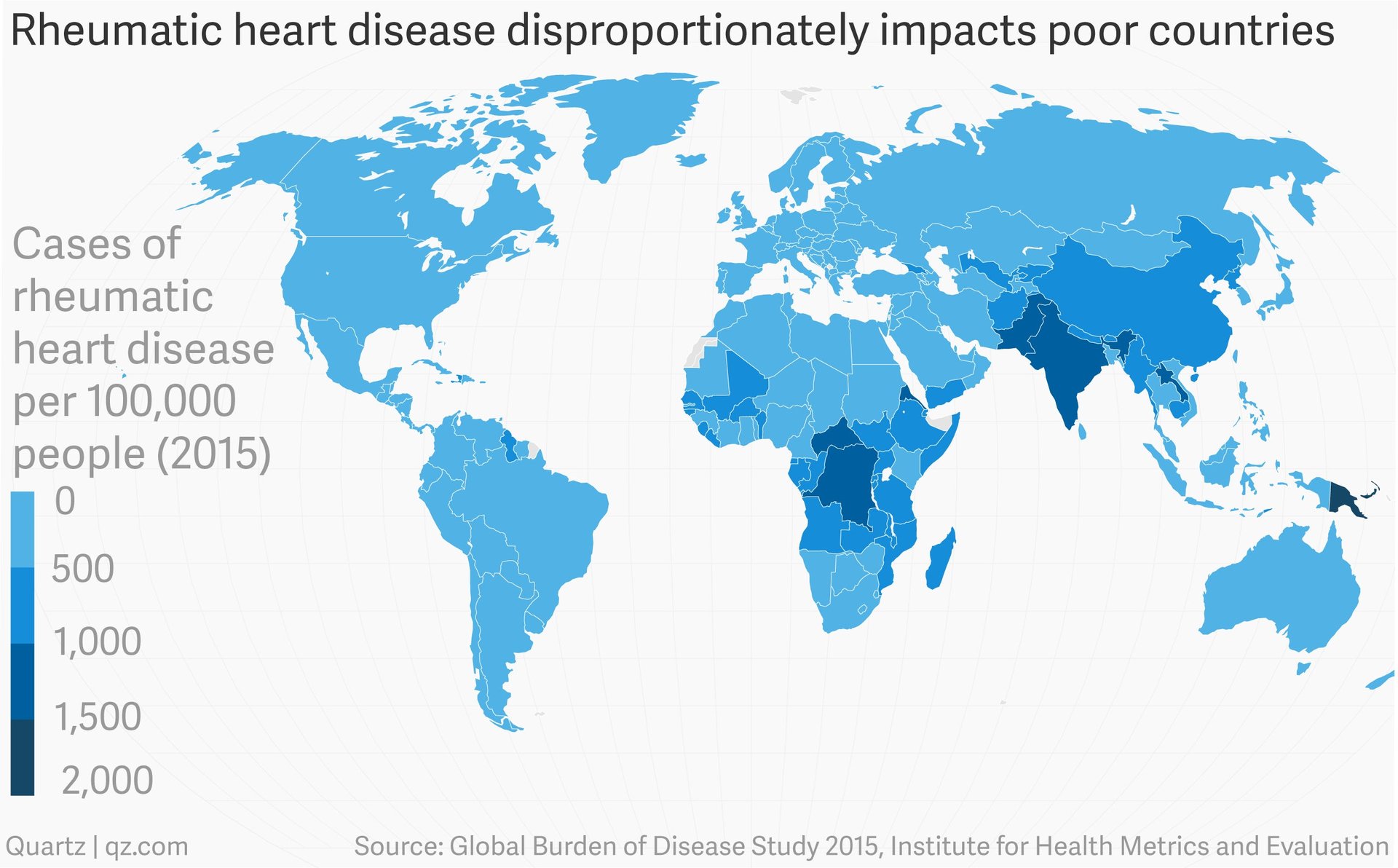Global penicillin shortages are bringing back old diseases, and creating new, deadlier ones
Stella Ngubenkomo was 11 when she found out she suffered from rheumatic heart disease. “The doctor said I wouldn’t live long,” she says.


Stella Ngubenkomo was 11 when she found out she suffered from rheumatic heart disease. “The doctor said I wouldn’t live long,” she says.
The doctor was wrong, but it hasn’t been easy; Ngubenkomo needs to get monthly penicillin injections to avoid heart failure and premature death. So once a month for the last 16 years, Ngubenkomo has gone to a local clinic in her hometown of Cape Town, South Africa, to get her dose of the antibiotic.
Benzathine penicillin G, a form of penicillin administered by injecting it into muscle, is the only medicine that can control rheumatic heart disease, which affects millions worldwide and kills thousands every year. It’s also a decades-old, proven drug, recognized by nearly all experts as an essential medicine for any country’s public health toolkits. And for the past few years, there have been global shortages of the medicine, putting Ngubenkomo’s life—and the lives of millions across the world—at risk.
At least 18 countries, including South Africa, the US, Canada, Portugal, France, and Brazil, have faced shortages of benzathine penicillin G over the last three years, according to the World Health Organization (WHO). With only a few companies in the world still manufacturing the medicine, countries can’t find enough supply of the drug that changed modern medicine 76 years ago.
No one makes penicillin anymore
Penicillin was discovered in 1928, but it really took off during World War II. In the early 1940s, a US government-led program brought together around 20 commercial firms, plus government and academic research laboratories, who collaborated to scale up penicillin production to supply the military. The goal, according to the book Sickness and Health in America, was to have enough penicillin for the troops landing in France in June 1944. In March 1945, penicillin was, for the first time, made available for consumers across the US. It’s efficacy made it popular: by 1949, the US annual production of penicillin was 1.3 trillion units—compared to the relative pittance of 1.7 billion units in 1944.
Penicillin was one of the great achievements of modern medicine. It was the first drug of its kind, considered a miracle, and ushered in the era of antibiotics. Before penicillin, any cut could kill if it got infected; surgeries of any kind could be fatal; and bacterial infections such as strep throat could kill. Gonorrhea, syphilis, and other sexually transmitted illnesses were basically a death sentence. But a single shot of benzathine penicillin G was enough to kill the first stages of syphilis, which had plagued humankind for over 500 years. It could also cure gonorrhea and other infectious disease. Today, benzathine penicillin G is still the most effective drug against deadly diseases such as rheumatic heart disease and syphilis.

Over the years though, penicillin descended from a wonder drug used on everything to a cheap, old antibiotic that pharmaceutical companies decided was no longer worth their while to produce for an ever-shrinking group of indications (gonorrhea, for example, is no longer treated with penicillin). Most moved on to more profitable products, focused on chronic diseases such as cancer and diabetes. Today, just four companies in the world still produce the active ingredient for benzathine penicillin G. Three are in China: North China Pharmaceutical Group Semisyntech Co., Ltd; CSPC Pharmaceuticals Group Ltd.; Jiangxi Dongfeng Pharmaceutical Co. Austria-based Sandoz GmbH is the only producer of the active ingredient for benzathine penicillin G in the Western world.
Together, these producers have the capacity to deliver up to 600 metric tons of benzathine penicillin G a year, but they produce less than 20% of that. “There is no money in penicillin,” says Amit Sengupta, the New Delhi-based global coordinator of the People’s Health Movement. A shot of benzathine penicillin G typically costs between $0.20 and $2.00, and usually all you need is one—strep throat and syphilis are both cured with a single injection of penicillin.
Meanwhile, global demand for the drug is not accurately captured because many poor countries don’t have the resources to quantify the true burden of diseases like syphilis and rheumatic heart disease. “There is not a lot of visibility of what the market for this drug looks like,” says Maggie Savage, from the New Market Opportunities Team at Clinton Health Access Initiative, which undertook a review of the global availability of benzathine penicillin G last year.
This is aggravated by the fact that nations with lower purchasing power tend to be the ones that need penicillin the most. “There is a market failure in the penicillin sector: there is a demand, but it comes from the poor,” says Ganesan Karthikeyan, a cardiologist at the All India Institute of Medical Sciences in New Delhi.

India has more rheumatic heart-disease-related deaths than any other in the world, with 111,000 fatal cases in 2015, according to the WHO. But there might be even more than that. Poor people in India do not typically have access to health care—there is no universal health care and the majority of treatment that does happen in the country is done by the private sector—which also means the country is not accurately tracking the illnesses afflicting the poor. Since rheumatic heart disease typically afflicts the poor, India is likely full of sick people who need penicillin that, essentially, no one knows about. With no clear forecasting and a cheap sales price, the drug has been in low supply in the country for the last 15 years.
India is just one example; it’s like this all over the world. Some 33 million people globally suffer from rheumatic heart disease and need monthly shots of penicillin; the WHO counts over 300,000 annual deaths due to the condition.
Another 5.6 million people around the world are infected with syphilis. And the WHO estimates that a single shot of penicillin could have saved over 53,000 babies in 30 countries who died from syphilis acquired in the womb in 2012.
It’s not only poor countries:
In the US, a shortage of benzathine penicillin G since April 2016 has made treating syphilis nearly impossible, just when the illness seems to be developing into a major public health threat. Syphilis cases have more than doubled over the last decade in the US, and it’s no small thing; syphilis during pregnancy, when untreated, can leave newborns blind, deaf, and/or with serious bone malformations. It is also linked to a high rate of stillbirths and infant mortality. And benzathine penicillin G is the only antibiotic known to be effective in killing the syphilis bacterium in the fetus.
Pfizer, the sole provider of the medicine in the US, has been unable to meet the country’s full demand due to “manufacturing delays” in its plant in the US, where it formulates the drug with ingredients from an international supplier, according to the company. Pfizer would not disclose what’s caused the shortage or where it currently sources the active ingredient for benzathine penicillin G (an investigation by the London-based group Changing Markets found Pfizer used to source penicillin from North China Pharmaceutical Group Semisyntech until at least 2015). The US Food and Drug Administration says it cannot provide details about the manufacturing delays, “as this information is considered confidential.”
The new, dangerous sources of drug ingredients
In the case of a low-profit medicine like penicillin, instead of going through the expensive process of making the drug themselves, local drugmakers will purchase the active ingredient for it from elsewhere, then formulate it for the local market. With lower labor expenses and cheaper utility bills, China has become the world’s largest supplier of active pharmaceutical ingredients, and the drugs assembled there—including benzathine penicillin G—are shipped everywhere.
“Penicillin production is difficult,” says Andy Gray, a pharmacologist at the University of KwaZulu-Natal, South Africa. “This is a product with no alternatives and you rely on a few huge global suppliers.”
That means a manufacturing delay or failure in one of these sites can affect several countries and millions of patients at once. For example, last November, the Chinese government told companies in Shijiazhuang, Hebei province, to halt production for 45 days as part of an anti-pollution measure. Two of the world’s four suppliers of the active ingredient in benzathine penicillin G—North China Pharmaceutical Group Semisyntech and CSPC Pharmaceuticals Group—had to shut down production.
Another problem in the supply chain of penicillin is compliance with quality standards. Semisyntech is part of one of the biggest Chinese drug groups, called North China Pharmaceutical Group Corp (NCPC). The conglomerate has over 25 subsidiaries manufacturing a wide range of pharmaceutical products sold to drug companies worldwide.
Over the last seven years, inspections carried out by drug agencies from various EU member-states have found NCPC’s companies non-compliant with good manufacturing practices multiple times. For example, in November 2014, inspectors from the French National Agency for Medicines and Health Products Safety visited the Semisyntech factory in Shijiazhuang, and found all sorts of problems: The factory had manipulated and falsified documents, its quality control lab lacked data integrity, and the plant had let standards slide to the point where the agency believes there was a high contamination risk.
The French authority recommended that the European Union prohibit the company from supplying penicillin to member countries. The European Directorate for the Quality of Medicines responded by revoking a number of NCPC’s Semisyntech “certificates of suitability,” issued to companies complying with strict quality standards set by the EU for safe medicines.

Other countries followed suit: Hong Kong, Ethiopia, and Liberia recalled local products made with ingredients from the Chinese plant and distributed by French drugmaker Laboratoires Panpharma. In 2015, Brazil decided to deny requests made by Semisyntech to sell benzathine penicillin G in their country—despite Brazil’s desperate need, thanks to a shortage of the medicine amid a syphilis outbreak at the time.
But things only worsened, and in April 2016, Brazil had no choice but to buy up an emergency stock of 2.7 million vials of benzathine penicillin G from the Pan-American Health Organization. And then, in July 2016, Brazil made the controversial decision to let NCPC’s Semisyntech ship penicillin ingredients into the country.
According to Brazilian law, pharmaceutical companies must submit documents outlining the manufacturing process of the materials they produce in order to receive a “registry,” which is issued to products considered safe and efficient. In the case of NCPC’s Semisyntech, Brazilian authorities granted a waiver allowing three Brazilian drugmakers to import the unregistered active pharmaceutical ingredient for benzathine penicillin G from the Chinese manufacturer.
Sourcing drugs from factories that don’t meet minimum quality standards increases the risk that contaminated medicines and poisonous ingredients ending up in hospitals, says Natasha Hurley, campaigner manager from Changing Markets Foundation, which has investigated drug company supply chains over the last few years.
Those risks can have fatal consequences. In 2008, a blood thinner formulated with ingredients from a Chinese manufacturer called Changzhou SPL Company Ltd. and sold by Baxter Healthcare Corporation in the US was connected with at least 81 deaths in the country. In Germany, there were reports of severe allergic reactions to a version of the blood thinner formulated by Rotexmedica, also with ingredients from China. The drug was recalled. After the incident, the US Food and Drug Administration reviewed the plant where the blood thinner was made and found the site (pdf) was non-compliant with good manufacturing practices.
But with such a small number of manufacturers responsible for the global supply of penicillin, regulators find themselves in a tough position: restrict supply from a manufacturer with critical deficiencies on their site, or look the other way and avoid a shortage of life-saving medicines?
“Very difficult risk-benefit judgements had to be made between poor quality processes or product, or no product at all,” wrote the European Medicines Agency in a 2012 report about drug shortages caused by non-compliant manufacturing. “The ability of regulators to take action against a manufacturing site was restricted in order to avoid product shortages.”
Penicillin shortages are creating new superbugs
Brazil’s ministry of health says the North China Pharmaceutical Group Semisyntech waiver is a temporary solution. The ministry has been encouraging local companies to manufacture penicillin, a spokesperson wrote in an email, and it plans to reduce reliance on active ingredient imports for essential medicines. Neither Brazil’s health ministry or the country’s drug-regulatory agency, Anvisa, replied to questions about measures put in place to assess the medicines produced with the unregistered ingredients from China.
Meanwhile, the penicillin shortages continue, and when the drug is not available many doctors are forced to use substitutes—”second-line drugs, such as macrolides,” says Lola Stamm, a microbiologist at University of North Carolina, author of a recent paper on mutations leading to syphilis-resistant bacteria. That, in turn, is fuelling one of the globe’s biggest public health threats: antibiotic resistance.
Macrolides like erythromycin and azithromycin have been used since the 1950s as a second option to treat group A strep throat infections and syphilis. But over the last decade, researchers have found increasing macrolide resistance in group A strep in Argentina, France, Canada, China, the US, and many others. Similarly, scientists have documented genetic mutations in Treponema pallidum pallidum, the bacterium that causes syphilis, that have made it resistant to macrolides. Researchers from the University of Zurich recently sequenced dozens of samples of syphilis infections from across the globe, and discovered that an increasing number of Treponema strains now fail to respond to azithromycin.
Benzathine penicillin G is a narrow-spectrum antibiotic that kills a few specific types of bacteria; azithromycin is broad spectrum, targeting multiple species of bugs in the human body, including some non-harmful ones that naturally live in the patient’s gut. This normal bacterial flora then develop various resistance mechanisms against broad spectrum antibiotics, says Vikas Manchanda, assistant professor at the Maulana Azad Medical College, in New Delhi, and then may transfer resistance to harmful bacteria—like Streptococcus pneumoniae.
Drug-resistant bacteria are a major public health threat worldwide. A recent report commissioned by the UK government estimates that, globally, 700,000 lives are lost every year to drug resistance. The problem is growing, the report says: resistant organisms will kill as many as 10 million people a year by 2050. This is the sort of doomsday scenario that prompted the WHO to name antibiotic resistance one of the three most important public health threats of the 21st century (along with foodborne diseases and outbreaks associated with malicious or accidental release of dangerous germs).
Bacterial evolution to adapt to the drugs that are meant to kill them was documented soon after the introduction of the first antibiotics. For example, penicillin-resistant strains of Staphylococcus aureus, linked to life-threatening diseases such as pneumonia and meningitis, began to rise as penicillin became widely available after World War II.
But at first, resistant pathogens were not a major threat as several new drugs launched between the 1950s and 1980s kept humans ahead of bacteria in the arms race. But recently, resistance has become a growing problem as the discoveries of new antibiotics drastically slowed down, while shortages of old and useful drugs are on the rise, limiting the options available for treatment. According to data from the US Centers for Disease Control and Prevention, between 2005 and 2014, only nine new antibiotics were developed and approved in the US, compared to 27 approved in the 1980s. Of the 2,240 new drugs in development in 2016, only 8% were anti-infectives (a group that includes antibiotics), according to a recent report by QuintilesIMS Institute.
Fewer antibiotics are being developed because these drugs now have lower margins than other medicines, such as those targeting rare and chronic diseases. The net present value—a number meant to capture the projected costs and revenues of a product—for injectable antibiotics is just $100 million, compared to, say, the $1 billion attached to drugs to treat musculoskeletal disorders, such as arthritis, according to a 2011 study from the London School of Economics.
“We need new antibiotics, but we also need to preserve the existing ones because they can save us right now,” says Céline Pulcini, a researcher at the Centre Hospitalier Universitaire in Nice, France. Pulcini led a 2015 study on global shortages of old antibiotics, which found that medicines useful against resistant bugs, including benzathine penicillin G, were available in only 20 of the 39 countries surveyed, mainly due to economical reasons. “There is a very strong focus on new drugs but almost nothing much is said about existing ones,” says Pulcini. “And that is basically because there is no much money in this market. The price is so low that nobody is interested.”
Government to the rescue?
“It must be a top priority for governments to solve this,”says Pulcini. “We need new businesses models and incentives to have old antibiotics in the market, otherwise we will just lose these drugs.”
It’s almost certain that pharmaceutical companies will not return to fill the penicillin gap. Paradoxically, the drug’s success is what has made it toxic to the private sector; many countries put price caps on drugs they consider essential and life-saving—including penicillin. “This means companies can’t sell the medicine at a true market value, so there is no real market for the drug,” says Karthikeyan, of the All India Institute of Medical Sciences.
“If you are a manufacturer and you have different markets you could sell to, what would you choose: one where there is a price constrain or somewhere else?” says Stavros Nicolaou, a senior executive at South Africa’s based Aspen Pharmacare, which markets pharmaceutical products to over 150 countries. Nicolaou believes government subsidies are needed to ensure regular supply of the drug. “If there aren’t, don’t be surprised if there are global shortages and if people can’t get treated.”
A number of countries are starting to explore these sorts of models. Brazil, for example, has promised to spend $2 billion to build partnerships with public and private drugmakers to produce the ingredients needed to make essential medicines, including penicillin, in the country. It’s also giving financial benefits to private drugmakers who agree to share technology with public drugmakers as a way of reviving the cheap-medicines sector. The measure could mean the country would no longer have to rely on the fragile global supply chain for penicillin.
There are many critics, though, of these sorts of public-private partnerships. Sengupta, from the People’s Health Movement, believes governments shouldn’t be subsidizing penicillin production. He argues that penicillin is already profitable, just not as much as companies would like it to be—the only solution, he believes, is for governments to produce the drug themselves. “Penicillin is a classic case of what economists call a market failure and this is why you need government intervention,” he says.
But many are skeptical about whether public production of medicines is viable long-term. Previous iterations of the model haven’t exactly been resounding successes. India, for example, tried setting up a public drugmaker in the 1950s. Called Hindustan Antibiotics Limited, it stayed afloat a few decades before going bankrupt in the 1990s.
While experts argue over the best model for penicillin production, those who need the medicine endure consequences that should be avoidable.

Benzathine penicillin G is the only drug that can cure syphilis in pregnant women. In Brazil, there were about 14,000 babies born with congenital syphilis in 2013. The shortage hit the following year; and ”doctors resorted to other antibiotics,” says professor Regina Rocco, gynecologist at Hospital Gaffrée e Guinle in Rio de Janeiro. They didn’t work: by 2015, the number of congenital syphilis cases in the country rose about 35% to nearly 19,000.
This project was funded by the European Journalism Centre via its Innovation Development Reporting Grant Programme.